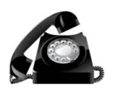Fiber Optic Benefits for Toll Free Service
The Fiber Optic PSTNetwork Holds The Key

by Allan Bishop
TollfreeNumber.ORG
VOIP is being pushed as the telecommunication method of the future. In theory the principle is sound; use the existing Internet network to transmit voice data from transmitter to receiver.
However this innovative new technology is proving much more difficult to implement and perfect. The end result is a lack in quality and performance when compared to fiber optic telephone lines.
These fiber optic telecommunication networks still have several influential benefits that VOIP simply cannot match.
PSTN = the Public Switched Telephone Network
Even during massive disruptions like Super Storm Sandy of 2011 or hurricane Katrina people were able to pick up some payphones that were connected to the PSTN and they still worked.
Fiber Optic Quality Counts
 Sound quality and clarity is essential to any voice data transmission. The American public are used to the level of quality that the PSTN offers and at present VOIP is simply not capable of reaching that sort of level.
Sound quality and clarity is essential to any voice data transmission. The American public are used to the level of quality that the PSTN offers and at present VOIP is simply not capable of reaching that sort of level.
The method by which the data packages are transported using VOIP means that long delays and obtrusive interruptions are evident. Generally, the quality of VOIP calls is around the same level as that of cellular phones and in some cases it has been reported that the static interference is actually worse.
Fiber Optic networks, on the other hand, bring a new dimension to traditional metallic phone lines. They offer much less resistance and, therefore, greater sound clarity.
The Standards Are Already Set.
 Phone networks and traditional telecommunications systems are all governed by the same standards. This means that the consumer is able to pick up a telephone and ring any other telephone without fear of finding that the two gateways are incompatible.
Phone networks and traditional telecommunications systems are all governed by the same standards. This means that the consumer is able to pick up a telephone and ring any other telephone without fear of finding that the two gateways are incompatible.
VOIP is still a developing technology with no designated standards to adhere to. Due to the constraints and issues with VOIP it looks as though it may take longer to resurrect many of these issues and it is unlikely that any industry standards will be set until this happens.
Loss Of Data.
 Sending data over the Internet does not require as robust a system as sending voice data does. When data becomes corrupted in any way, the transmission of this data will fail and while in the case of text and graphical data this isn’t a great issue, it becomes an issue with voice data.
Sending data over the Internet does not require as robust a system as sending voice data does. When data becomes corrupted in any way, the transmission of this data will fail and while in the case of text and graphical data this isn’t a great issue, it becomes an issue with voice data.
The lag that is experienced on VOIP calls is notable even though it is measured in milliseconds. This delay is not desirable in an industry where essentially no delay is witnessed. With traditional telephone cables it is possible to call the other side of the world with only a few hundred milliseconds delay.
However, making any VOIP call has a delay of between 400 and 2000 milliseconds.
The fact is that at present, fiber optic cables look to be a more reliable, robust, and secure method of making telephone calls. While this situation may change in the future there are a number of potentially dramatic changes required before this will happen. In the meantime VOIP users will still be confronted with these issues.
The information provided on this page may be freely reproduced as long as this footer tag remains intact and credit is given to Tollfreenumber.ORG as the author and a link is placed to tollfreenumber.org. Please do not violate copyright laws by stealing this, or any other works on the Internet.
This article was written by Tollfreenumber.ORG. Tollfreenumber.ORG is a premier website specializing in toll-free phone numbers. We feature an online phone directory, an alpha-numeric telephone number translator, & Toll Free Family-oriented phone service. We have a speciality business accounts department dedicated to providing businesses with one-on-one toll-free advice.







